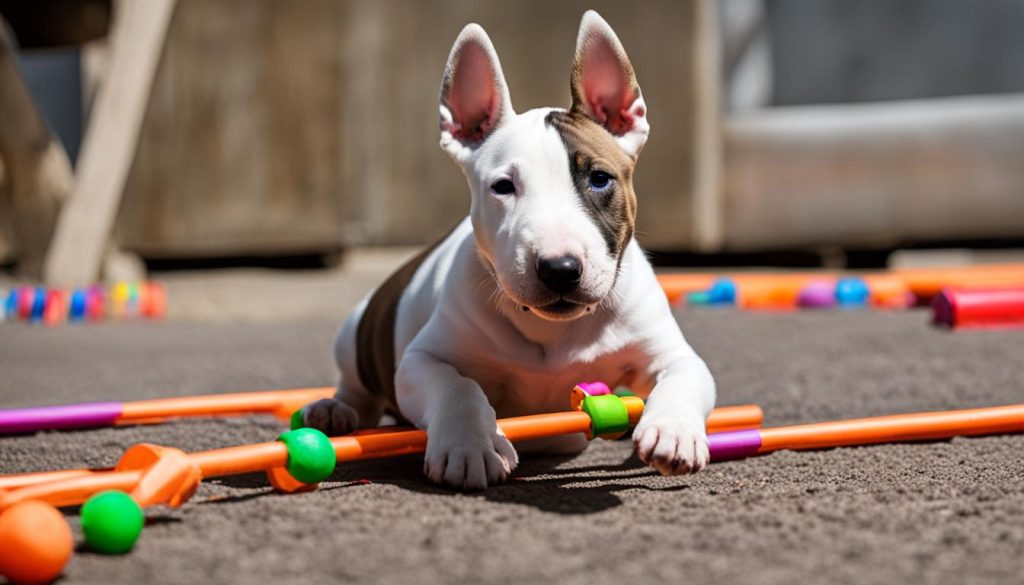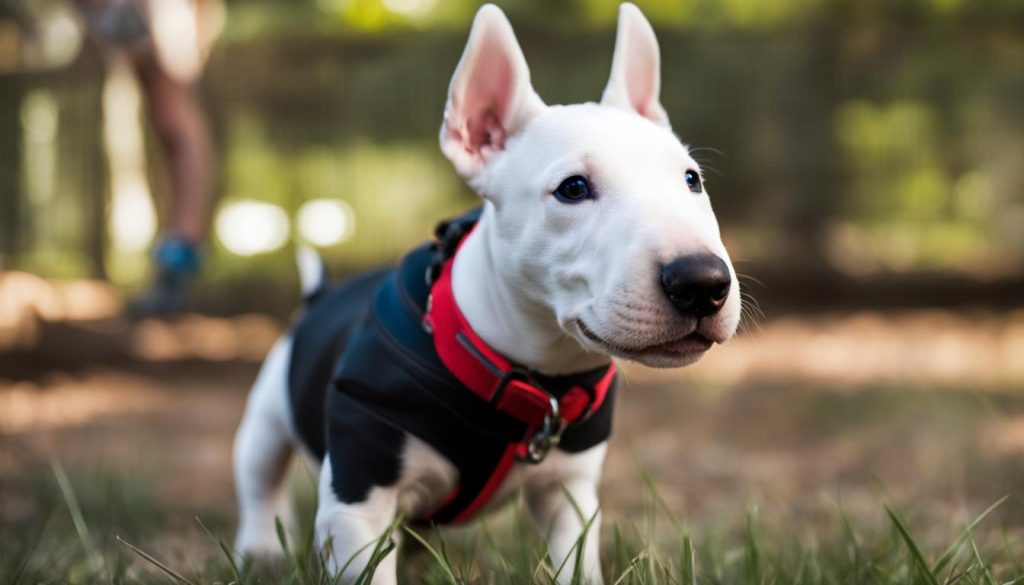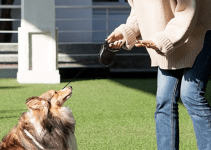Training a Bull Terrier can be both challenging and rewarding. These lovable dogs are known for their playful personalities and stubborn nature, making it essential to approach their training with the right techniques. Whether you’re a seasoned dog owner or a first-time Bull Terrier parent, this article will provide you with secrets for teaching your Bull Terrier obedience and good behavior. From understanding their unique temperament to using effective Bull Terrier training methods, we’ll explore the best strategies for Bull Terrier training.
Understanding Bull Terrier Training
- Start training your Bull Terrier puppy early to establish clear boundaries and expectations.
- Consistency is key when it comes to training your Bull Terrier, ensuring everyone in the household uses the same commands and rewards.
- Use positive reinforcement, such as praise and treats, to reward good behavior and associate positive outcomes with desired actions.
- Keep training sessions short and engaging to cater to your Bull Terrier’s attention span and maximize their learning potential.
- Use clear, one-word commands to avoid confusion and help your Bull Terrier understand what is expected of them.
Start Your Bull Terrier Puppy Early
One of the most important secrets to successful bull terrier puppy training is to start early. It’s never too early to begin teaching your puppy basic obedience commands like “sit,” “stay,” and “come.” Early puppy training is crucial for establishing boundaries and expectations, which makes it easier for your puppy to learn good behavior.
During the early stages of training, your bull terrier puppy is like a blank canvas, eager to learn and please you. By starting their training early, you can shape their behavior and instill good habits from the very beginning.
Begin by introducing your puppy to their new home and gradually introducing them to new experiences and social interactions. This will help them build confidence and adapt to new situations.
Teaching your puppy basic obedience commands not only sets them up for success in their everyday life but also ensures their safety. For example, teaching them to come when called can prevent accidents or dangerous situations when they’re outside or around distractions.
When Bull Terrier training, keep in mind that young puppies have shorter attention spans. Therefore, it’s best to keep the training sessions short, around 5-10 minutes, to ensure they stay engaged and motivated. Use positive reinforcement techniques such as treats, praise, and play to reward good behavior and make the training experience enjoyable for both you and your puppy.
Establishing Boundaries and Expectations
Setting clear boundaries and expectations is essential during early puppy training. Dogs thrive on structure and routine, so it’s important to establish rules from the beginning.
Decide what behaviors are allowed and what behaviors are not, and consistently reinforce these boundaries. For example, if you don’t want your puppy on the furniture, teach them to stay off and redirect them to their designated sleeping area.
Remember to use positive reinforcement when your puppy follows the rules and correct them gently when they don’t. With time and consistency, your bull terrier puppy will learn what is expected of them and develop good habits.
Starting early with bull terrier puppy training and establishing clear boundaries and expectations will lay the foundation for a well-behaved and obedient adult dog.
Consistency is Key with a Bull Terrier Puppy
When it comes to puppy training, consistency is the key to success. By using the same commands and rewards, you can avoid confusion and establish clear expectations for your Bull Terrier puppy. Consistency in your approach, schedule, and expectations will pave the way for a well-trained and well-behaved companion.
Training a puppy requires teamwork, so it’s essential to ensure that everyone in your household is on the same page. By using consistent commands and rewards, you can avoid sending mixed signals and create a harmonious training environment.
Consistency is not just about using the same words; it’s also about using the same tone of voice and body language. Dogs are experts at picking up on subtle cues, so maintaining consistency in your overall approach is crucial.
By using the same commands and rewards consistently, you help your Bull Terrier puppy understand what is expected of them. This clarity allows them to learn and respond more effectively, leading to better overall training results.
The Importance of Clear Expectations
Establishing clear expectations is vital for a Bull Terrier puppy’s training. By consistently using the same commands and rewards, your puppy will quickly learn what behaviors are desired and rewarded.
Consistency helps avoid confusion and prevents your puppy from becoming frustrated or anxious. When expectations are unclear or inconsistent, puppies may feel unsure about what they need to do, which can hinder their learning progress.
When you set clear expectations through consistent training, your Bull Terrier puppy will feel more confident and secure. This sense of clarity helps them understand their role in the training process and encourages them to become eager learners.
The Role of Consistency in Building Trust
Consistency is not just about Bull Terrier training; it also plays a crucial role in building trust with your Bull Terrier puppy. When you consistently apply the same commands and rewards, your puppy learns to trust your guidance and understands that you are a reliable source of instruction.
Trust is the foundation of a strong bond between a dog and their owner. By establishing clear expectations through consistent Bull Terrier training, you create a sense of reliability and safety for your puppy. This trust forms the basis for a strong and lasting relationship built on mutual understanding and respect.

Consistency is key when training a Bull Terrier puppy. By using the same commands and rewards, avoiding confusion, and establishing clear expectations, you can lay the groundwork for a well-behaved and obedient canine companion.
Using Positive Reinforcement with Your Bull Terrier
When it comes to Bull Terrier training, positive reinforcement is a highly effective and humane approach. This training method focuses on rewarding good behavior, allowing your puppy to understand what is expected of them and associating positive outcomes with their actions.
Positive reinforcement can take various forms, such as praise, treats, or playtime. Whenever your Bull Terrier exhibits the desired behavior, promptly reward them with enthusiastic praise and affection, a tasty treat, or an engaging play session. This positive reinforcement helps your puppy make a positive connection between their actions and the enjoyable outcomes they receive.
Keeping Training Sessions Short and Engaging
Puppies have a limited attention span, so it’s important to keep training sessions short and engaging. Aim for sessions that last around 10-15 minutes, 2-3 times a day. By keeping the sessions brief, your Bull Terrier will remain focused and retain the information better. Remember, it’s about quality over quantity when it comes to successful training sessions.
During these short sessions, make sure to incorporate interactive and stimulating activities that capture your puppy’s interest. Use toys, treats, and positive reinforcement techniques to keep them engaged and motivated to learn. Vary the exercises and commands to prevent boredom and maintain their enthusiasm.
Remember that puppies have a shorter attention span compared to adult dogs, so keeping the training sessions short and interesting will help prevent them from becoming overwhelmed or losing interest. Regular, short sessions are more effective than one long session, ensuring that your Bull Terrier puppy can absorb and apply what they’ve learned.

Using Clear, Simple Commands with Your Bull Terrier
When it comes to teaching your Bull Terrier obedience, using clear and simple commands is key. Clear commands are easier for your dog to understand and follow, leading to better results in their training. Stick to one-word commands like “sit,” “stay,” “down,” and “come” for clarity and consistency.
By using one-word commands, you provide a straightforward and easy-to-understand instruction for your Bull Terrier. This makes it easier for them to associate the command with the desired behavior, reducing confusion and accelerating their learning process.
Remember to use consistent hand signals or gestures alongside verbal commands to reinforce the commands further. This visual cue helps your Bull Terrier connect the action with the command, facilitating better comprehension and response.
Here are some examples of clear, one-word commands:
- Sit: Use this command to instruct your Bull Terrier to sit down.
- Stay: Use this command to teach your dog to remain in place without moving.
- Down: Use this command to command your Bull Terrier to lie down.
- Come: Use this command to call your dog towards you.
By consistently using clear, one-word commands and reinforcing them with hand signals, you can effectively communicate your expectations to your Bull Terrier and achieve better results in their training.
Patience is Key with Your Bull Terrier
Patience is essential when training a Bull Terrier puppy.
Remember that your puppy is still learning and may not grasp everything right away. Stay calm and composed during training sessions and give your puppy the time they need to understand and learn new commands. Every puppy is different, and some may take longer to learn than others.
It’s important to remain patient and avoid becoming frustrated or discouraged. Your Bull Terrier relies on your guidance and positive reinforcement to learn and develop good behavior. By staying patient, you create a relaxed and supportive environment for your puppy to thrive in.
During Bull Terrier training sessions, maintain a calm and confident demeanor. Dogs can sense emotions, so it’s important to stay calm and focused. Your puppy will respond better to training when they feel safe and supported.
Conclusion
Effective bull terrier training requires the right techniques and a patient, consistent approach. By understanding the unique personality traits of Bull Terriers, such as their stubbornness and playfulness, you can tailor your training methods to achieve the best results. Remember to prioritize positive reinforcement over punishment, using rewards and praise to encourage good behavior.
Consistency is key in bull terrier training. Use clear, simple commands and establish clear expectations to avoid confusion. Short, engaging training sessions will keep your bull terrier focused and help them retain information better.
While you navigate the challenges of training your bull terrier, it’s important to consider professional dog trainers who specialize in positive reinforcement training. Their expertise can be invaluable in overcoming any training difficulties and fostering a strong bond with your furry friend.
With patience, the right techniques, and professional guidance if needed, you’ll be well on your way to having a well-behaved and happy Bull Terrier companion. Happy Bull Terrier training!
FAQ
When should I start training my Bull Terrier puppy?
It is recommended to start training your Bull Terrier puppy early. As soon as you bring them home, you can begin teaching basic obedience commands like “sit,” “stay,” and “come.”
Why is consistency important in Bull Terrier puppy training?
Consistency is crucial in puppy training to avoid confusion. It is important that everyone in your household uses the same commands and rewards to establish clear expectations and help your Bull Terrier understand the desired behavior.
How can positive reinforcement help in training my Bull Terrier?
Positive reinforcement is a powerful tool in puppy obedience training. By rewarding your Bull Terrier with praise, treats, or playtime when they exhibit good behavior, you help them associate positive outcomes with the desired actions, increasing the likelihood of repetition.
How long should each training session be for my Bull Terrier puppy?
Training sessions for Bull Terrier puppies should be kept short, around 10-15 minutes, 2-3 times a day. This helps your puppy remain focused and retain the information better. Remember, quality over quantity is key in successful training sessions.
What type of commands should I use when training my Bull Terrier?
When teaching your Bull Terrier obedience, it is best to use clear and simple commands that are easy for them to understand. Stick to one-word commands like “sit,” “stay,” “down,” and “come” for better results. Using multiple words for the same command can confuse your puppy.
How important is patience when training a Bull Terrier puppy?
Patience is essential when training a Bull Terrier puppy. It is important to remember that every puppy is different and may take longer to learn. Stay calm and composed during training sessions, giving your puppy the time they need to understand and learn new commands.






